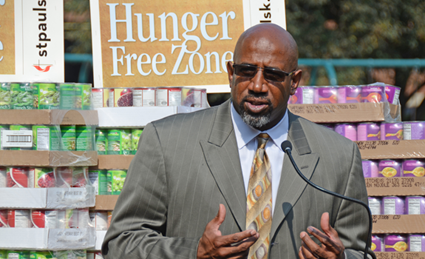
Maryland church aims for Hunger-free' ZIP Code
By Erik Alsgaard

Rev. Joe Daniels, superintendent of the Greater Washington District
St. Paul’s United Methodist Church in Kensington, Md., has set out to make the ZIP Code in which it resides—20895—the nation’s first “Hunger Free Zone.”
It all started three years ago. “We believed, with all our heart, that God was calling us to feed hungry people,” said the church’s pastor, the Rev. Adam Snell, speaking at a press conference Sept. 10 to unveil the new hunger initiative.
And the church responded in those days, he said, with small steps: feeding people at Thanksgiving and Christmas, handing out coupons to a monthly pancake breakfast the church held, and buying 2,500 re-usable bags that were handed out to members of the church with an invitation to fill the bag when they went grocery shopping and return the bag to the local food pantry.
“But today, it’s about to take a very big step,” Snell said. “It is a very big leap of faith for us.”
Speaking on the church’s front steps, Snell outlined a vision whereby, in partnership with Bethesda Help, an organization that provides emergency relief and food assistance to area residents, chronic hunger in 20895 would be eliminated.
“Our promise is that anyone living in 20895 who is hungry will be fed,” said Snell.
According to the 2010 United States Census, ZIP Code 20895 had a population of 19,054, with an average income per household above $111,000.[i] With those statistics, it might be hard to imagine anyone not having the resources to buy food, or anyone going hungry.
And yet, in 2012, Bethesda Help assisted more than 300 households, according to Karen Auerbach, president of the organization and another speaker at the press conference.

Rev. Adam Snell, pastor of St. Paul’s UMC in Kensington
“Through the first six months of 2013,” she added, “we’ve already helped 190 households. The need is there.”
In 20895, Snell said, there is a population of immigrants, transients and people who are hungry. “The need is great,” he said. “The reality is, it will always be great here. For whatever reasons, there are people who run short of food. When people call, and we’re able to respond and people get fed, it’s hunger-free.”
The church’s district superintendent, the Rev. Joe Daniels, spoke at the press conference and applauded the efforts of the congregation.
“It is always good to meet the needs of the community,” he said. “Hunger is a problem, not just here but throughout the region. This church is doing a wonderful work in meeting the need.”
Snell said that members of the church have three ways they can become involved in the campaign, either through being a driver to help deliver food, packing the food into boxes for delivery, or for someone to coordinate the responses to requests.
“We promise to deliver a three-day supply of food to those people who are hungry in our neighborhoods,” said Snell. “All they have to do is simply ask for it.”
To spread the word about the campaign, the church has produced lawn signs and postcards in both Spanish and English. Members of the congregation will be distributing the signs throughout the community, especially targeting other houses of worship.
How will Snell know when 20895 has become a hunger-free zone? “Ideally, when no more calls come in,” he said. “When we have gotten everyone to come up to a level where we can then look beyond our ZIP Code and help those around us.”

Login/Register to leave comment